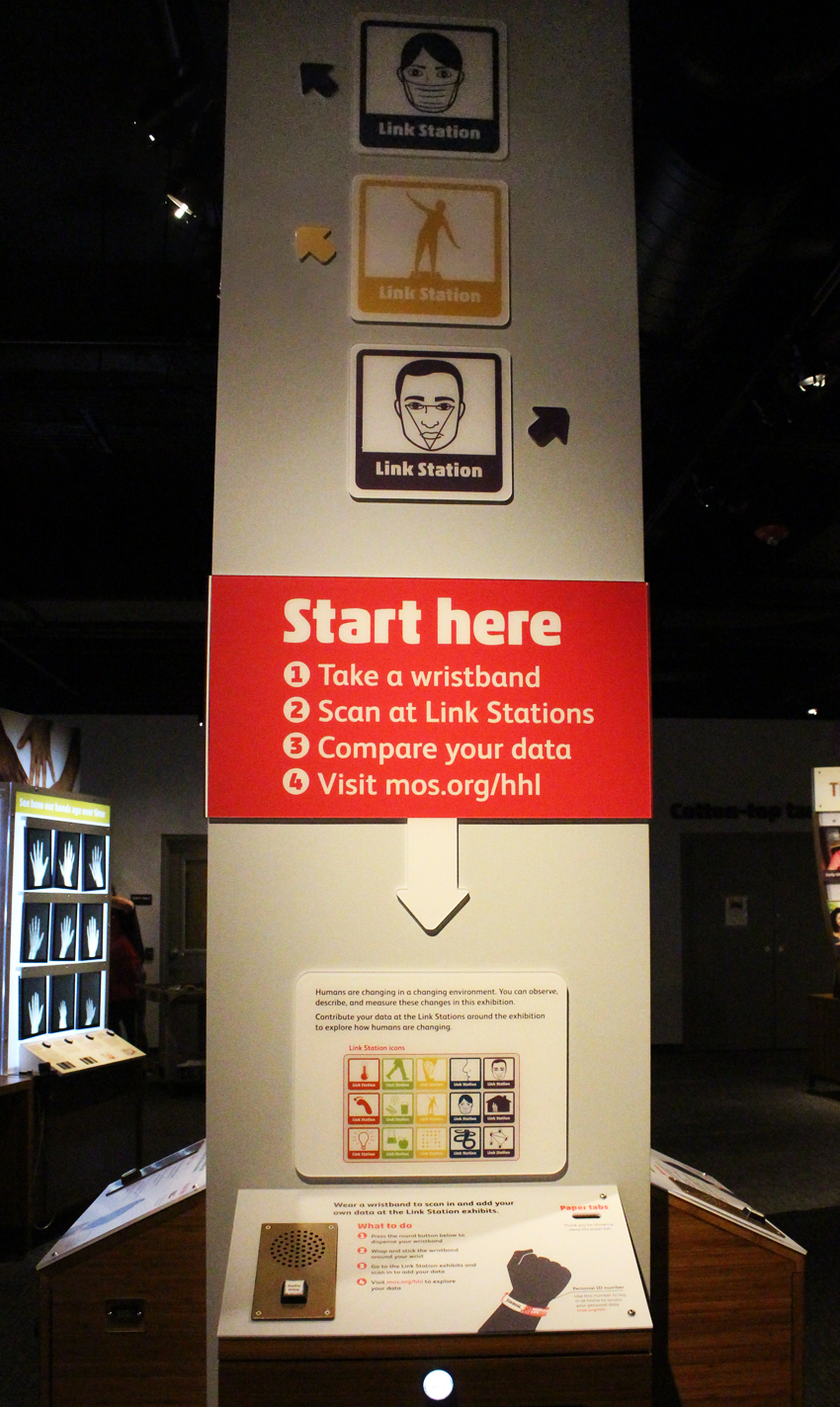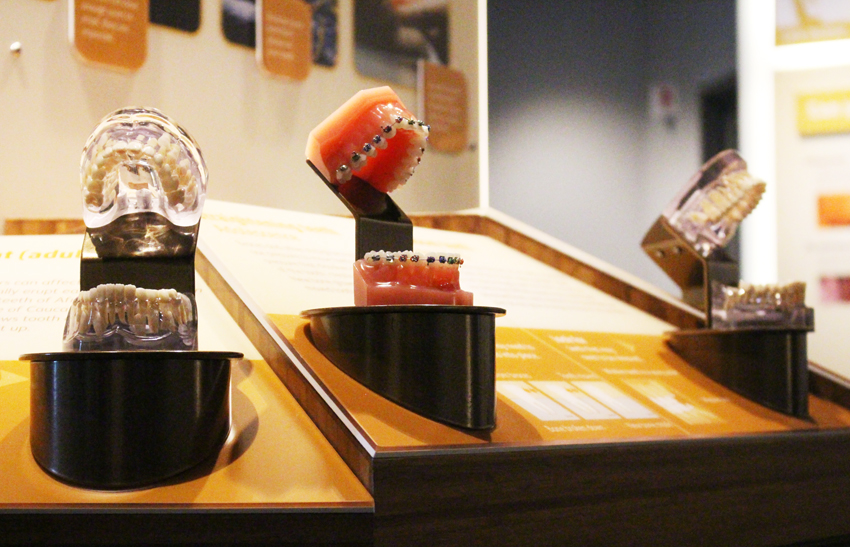Sneak Peek: The Museum of Science’s New Hall of Human Life

Exhibit manager Elizabeth Kong stands in front of the Hall of Human Life exhibit at the Museum of Science, which opens November 16. (Photos by Margaret Burdge)
Remember back to gazing up into the face of a giant dinosaur on your third-grade field trip. Do you ever miss the starry-eyed wonderment that an afternoon at the Museum of Science conjured up? Starting November 16, the Museum of Science will try to recapture that moment for adults with its newest exhibit, the Hall of Human Life.
With 70 interactive elements to challenge all ages, this massive new exhibit turns science on its head to reshape the traditional museum experience.
“Unlike a classroom, you don’t have to start from beginning to end,” says Elizabeth Kong, manager of the Hall of Human Life. “This is for you to explore on your own and to really enjoy.” With a custom ID bracelet, you can attack the 15 link stations as you please, adding your results to the larger pool of visitors and becoming a part of research being done at the exhibit.
By asking questions like “What is texting doing to our brains?” (it may be keeping you up at night), or “Should parents genome map their future children?”, the Hall of Human Life brings adults into the scientific discussion, while also keeping interactive elements that kids will understand. “We’ve been having these conversations at our kitchen table with our family, with our friends,” says Kong. “I think that’s really the role that the museum needs to play, to help with those conversations and to give a little information behind these topics that all of us are asking questions about.”
With researchers coming into the exhibit to collect data from the public, the Hall of Human Life offers museum-goers a chance to actually participate in the research. “I think some of the complaints in the past have been, ‘What are parents going to do?'” says Kong. “What do you do if you’re going on a date or something of that sort? This really feeds to all these different groups.”
With the help of more than 125 advisors and more than eight years of development, the Museum of Science has taken advantage of every resource to develop these concepts to the fullest in the new exhibit.
Here, Kong walks us through the Hall of Human Life, giving us an inside look at the interactive exhibit before its opening to the public on November 16.

Upon entering the Hall of Human Life, you are prompted to take a wristband with your own personal ID number to catalogue your results at each of the 15 interactive link stations. “This is beyond just looking at a monitor or screen,” says Kong. “This is more than just pressing a button. This is a chance for you to take part and measure something about yourself.”

“It’s just like at a CVS or a Macy’s,” says Kong of the scanning technology. Thanks to a unique ID number, personal data is added to a larger database of visitor experiences, and you can compare the findings at the end of each station, or input your number on mos.org/hhl to continue the learning from home. You can even enter family and friends’ numbers at the same time to compare and contrast the data.

How efficient is your walk? You can find out at this link station, which explains how many calories you burn while walking, but does so in number of grapes per mile. That’s right: grapes. What begins as an arbitrary number is explained in terms that kids can understand and will remember. And that’s the most unique part of the exhibit. According to Kong, it’s relatable to everyone. “Whether it’s about bees and honey and allergies, or about how efficient your walk is, there’s some concept of that that [kids] can address on their own and, scientifically, ask questions about,” says Kong.

For Kong, the best part of the Hall of Human Life is that it is about more than learning facts; it’s about asking questions. Many of the sections of the exhibit change out every six to eight months, including Provocative Questions where people are asked to sit across from each other and discuss polarizing topics, so as to keep up with advances in research.”We found that when people finished using this interactive, they were more willing to listen to other people on polarizing topics than they were when they started,” says Kong. “No one else has achieved anything like this in any other institution.”

In the Exploration Room, some of the classic pieces that were popular in The Human Body Connection (the exhibit previously in this space) were kept and reinterpreted for the Hall of Human Life. “People come to the museum and they love seeing a sheep’s lung inflated,” explains Kong. “Or they love looking at and being able to touch a real brain.” Whereas traditional components can stay up for years, Kong explains that the Hall of Human life will act as an “evolving exhibit,” with some elements like these that change on the hour and others that are updated every six to eight months.

This breeding pair of Tamarins is the first to enter the exhibit, which can hold up to six monkeys. As the only species other than humans that develops colon cancer, these animals offer a unique way of understanding human biology. The exhibit asks why it is that these creatures can develop the same disease when held in captivity, just one of the ways genetics are approached from a different perspective. Along with the Exploration Room, the chick incubator, and an updated version of the height chart where people can compare their height to each other and national averages over time, these Tamarins are elements that have been brought over from The Human Body Connection, which was transformed into the new Hall of Human Life, and revamped for the new exhibit.

In the live beehive, the bees that are normally housed on the roof of the museum can fly in and out of the observation case through the tube at the left, which connects out of the museum. With colony collapse at the forefront of science, the exhibit looks at the five factors related to human biology as they apply to these honeybees, and what effects humans are having on this population.

Through an immense amount of research, the creators chose to break the discussion of human biology into five environments based on common themes that emerged from paper after paper: food, organisms, physical forces, communities, and time. “We were really listening to what people were asking and getting a better sense of which questions [naturally evolve] from what people want to know,” explains Kong. For this reason, each section of the Hall is updated continually with fresh information, staying on top of the most current trends in the field.

Whether it is understanding allergic reactions through the sneeze of a giant nose or viewing different teeth structures to understand how the body develops and changes over time, the multimedia approach to the exhibit involves visitors in many ways beyond the traditional museum experience.

“Everyone says, ‘Oh, it’s just in my genetics,'” laments Kong. “But we want people to understand that that’s not the only story.” The Community section of the Hall allows museum-goers to reflect on the bigger picture of their health and biology. “The fact that we actually select things in our environment, that we’re changing the environment…how does that affect us? Not just physically, which we can measure here, but even down to the molecular level,” says Kong.

What does 2,000 calories actually look like? It’s more than you’d think. These types of questions are answered in the Food section of the exhibit, where tubes of grapes, cupcakes, carrots, and hot dogs light up to put a visual to the calorie count.

In addition to the researchers and large museum staff who worked on the exhibit, much of the technical production came from a team of in-house content and exhibit designers and graphic designers. With so many different elements from video to interactives and beyond, many hands have taken part in the creation of the Hall of Human Life. The same design team that worked on E. O. Wilson’s book, Life on Earth, for example, created this interactive in the Organism section.

The Human Body Theater projects onto two screens for a 3D effect without the glasses. With stories on aggression, immunity, prenatal developments, and more, the theater gives you a look at how industries work with the five environments to affect our health and biology.

“This is completely different,” says Kong of the way the Hall of Human life adds to the Museum of Science. “You’re able not just to exhibit these topics, but also to exhibit yourself.” At this link station, visitors test their balancing skills by controlling the path of the ball on the screen. While participants complete the activity, video from a museum staffer explains the task, and after it’s completed, explains the results in comparison to others who have finished the activity. “Not only do we talk to kids—kids can do this and have a great time—but this is a great place for adults to have a lot of fun,” says Kong. “It’s really a whole new way of approaching interactives.”
The Hall of Human Life opens Saturday, November 16, at the Museum of Science, 1 Science Park, 617-723-2500, mos.org.

